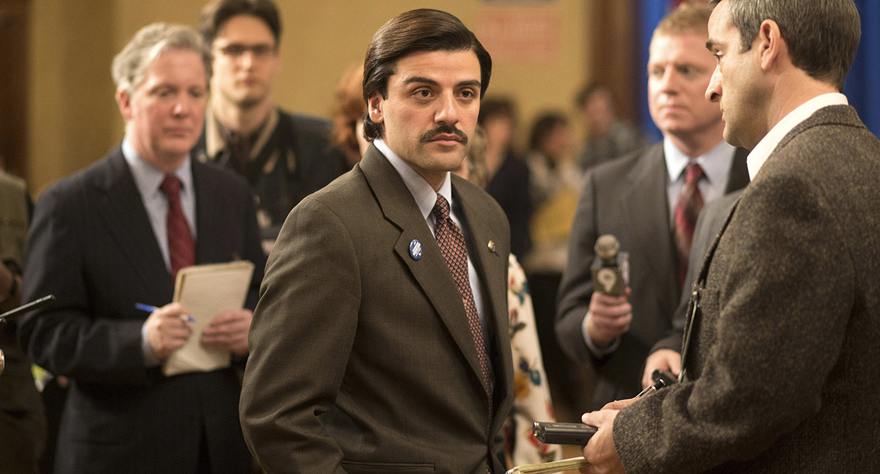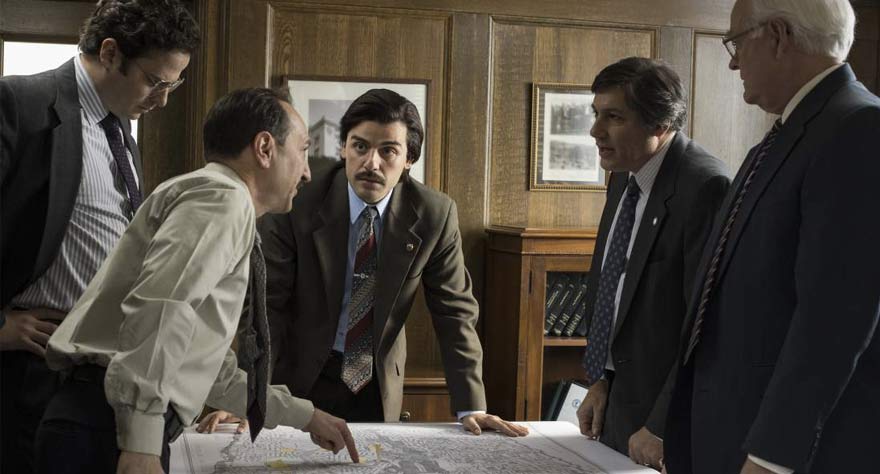Show Me A Hero: Part I and Part II

“Hey, this mayor thing…when’s the fun part start?”
In the opening moments of the new HBO miniseries, Show Me A Hero, so much is said without a single word spoken. A man parks in front of a cemetery, panting and hyperventilating before chugging two-thirds of a Maalox (antacid to treat dyspepsia), and ignoring his beeping pager. He leaves the car, pukes out the Maalox, and—in a brilliantly framed shot—walks into the distance while his pager flashes “911.” He sits by a gravestone marked “Wasicsko,” stressed, paranoid, and clearly at the end of his rope. Politics aside, these opening moments ensure one thing: writers David Simon and William F. Zorzi (ex-Baltimore Sun journalists and masterminds behind the greatest TV show of the century thus far, The Wire), director Paul Haggis (Crash, Third Person), and star Oscar Isaac (sizzling like a comet towards the A-list after his unforgettable turn in Inside Llewyn Davis) are going to make Show Me A Hero one of the most talked-about television events of the year through sheer artistic integrity.
That it has a timely political subject at its epicenter guarantees discussion and makes it all the more enticing. It’s the late 1980s, and we’re in Yonkers, New York. Now, depending on how much pre-hand knowledge one starts with—specifically concerning the public housing crisis that forms the molten-hot fulcrum of this story—one will either be affirmed or informed for the first couple of hours. Thanks to Simon and Zorzi’s experience in encyclopedic storytelling structure, the groundwork is laid out and easy enough to follow as long as you pay close attention. Yonkers is divided by the Saw Mill River Parkway; on the East side live the affluent, middle-to-upper class of predominantly white citizens, while the West side is made up of the housing projects populated by the predominantly non-white and poor. After federal judge Leonard Sand (Bob Balaban) issues an order to the City of Yonkers to install 200 units of low-income housing on the East side of the parkway, the middle-class community raise hell for the City’s incumbent mayor Angelo Martinelli (Jim Belushi) and his councilmen and women, among them 27-year-old Democrat Nick Wasicsko (Isaac), Republican Henry Spallone (Alfred Molina), and Council president Vinni Restiano (Winona Ryder). Hell is raised, not because of outward racism or prejudice, as one of the citizens tries to articulate, but because the property of their own houses for which they’ve worked hard to obtain and maintain will fall, while people who don’t make the kind of money they do get a federal free-pass to live in the same neighborhoods.
The first two hours of the show introduce us to the principal characters from both sides of the Parkway, and the personal and political struggles they carry. Martinelli is facing an election year and has grown increasingly unpopular with voters because he refused to appeal Sand’s housing mandate, while Wasicsko becomes convinced he’s got a shot to become the country’s youngest mayor, because he has, crucially, voted for the appeal. Meanwhile, his private life is imbued with an adorable romantic subplot as he courts and wins over a councilman’s new secretary, Nay Noe (Carla Quevedo). In Sand’s chambers, the NAACP are represented by a passionate and cynical Michael Sussman (Jon Bernthal) who pleads with the judge to make good on his promise and force the housing on the city, even if he doesn’t have the council’s approval. While housing expert Oscar Newman (Peter Riegart), who has canvassed the layout of Yonkers, believes the 200 units can and should be spread out over eight or more sites, in order to avoid further contempt and division within the community.
As the political soup brews on both local and federal levels, we get glimpses into some of the lives on the west side of the Parkway. There’s 47-year-old Norma (LaTanya Richardson Jackson) whose eyesight is deteriorating by the minute due to diabetes. We follow Carmen (Ilfenesh Hadera) and her three children as they struggle in New York and are forced to move back to the Dominican Republic. And we’re introduced to Doreen (Natalie Paul) who lives in the suburbs but visits the projects where she meets, falls in love, and moves in with a well-meaning, asthmatic, drug-dealer Skip (J. Mallory McCree). Keeping with the non-political level, in Part II we become acquainted with a couple of East Yonkers citizens, Mary (Catherine Keener) and Buddy Dorman (Brian Altman). When Nick becomes mayor-elect, and the housing appeal is denied, it forces Nick and his council to comply with Sand’s mandate or face hefty fines and contempt of court, while Mary joins the growing ranks of the angry rabble who refuse to give in to the idea of low-income housing in their community.

This first third of Show Me A Hero beckons you to immediately re-watch both parts depending on how well versed you are in political jargon, just to make sure all the appeals, elections, NAACP grievances, and court decisions make sense. Then again, people tuning into a new HBO miniseries from David Simon and William Zarzi should expect nothing less then to have their attentive faculties massaged to full capacity. All credit goes to Simon and Zarzi’s expert writing, which displays an incredible economy in character and story development. In two hours, we get the sense of an entire community and all its various shades, from slums to council meetings. Haggis’ direction, and some masterful editing from Jo Francis and Kate Sanford, delicately weave together all the pieces of the puzzle, allowing the virtuoso performances to shine through and keep eyes glued to the screen. Literally all of the players, spearheaded by Isaac all the way down to the secretary who comically refuses Wasicsko access to the copy machine, excel in their roles. As outlined in the opening minutes, Show Me A Hero is an intricate, controlled, and smoothly seismic piece of television. And we’re just talking about the first two hours here.
This kind of subject matter and story doesn’t just invite political discussion, it incites it. Based on Lisa Belkin’s nonfiction book of the same name, Show Me A Hero (the title, FYI, is taken from the F. Scott Fitzgerald quote, “Show me a hero, and I’ll write you a tragedy,” so wherever this is heading, it won’t be pretty) makes little qualms about which side its own. Molina’s Spallone chews on his toothpick with the menace of a Bond villain, the angry white mob of East Yonkers spew anti-Semitic slurs about Sand and Sussman, and the tenderization of the West-side characters is more mechanical than braising. Norma’s eyesight, for example, gets stretched to the point of heavy-handed manipulation: she can’t see the button she marked on her intercom to buzz herself in, and instead of trying any other apartment, she frets and tugs at our heart strings. On the other hand, there is a sense of level-headed balance. Spallone’s “I watched the Bronx die” argument has its roots in historical accuracy (depending on who you talk to), and the first proper sequence we see on the West side involves a drug-deal; the foremost concern for the East side of Yonkers. While most of the white citizens’ objections drown in a cacophonous sea of introverted racism, one can’t help but sympathize with someone like Mary Dorman (played with surgical subtlety by Keener), who is genuinely worried about how her way of life will be impacted by this change. The show makes a point to separate her from the rest of the bigots, and Part II’s conclusion—an unlikely phone conversation—foreshadows the kind of evolution both Mary and Nick are about to go through.
That it’s a liberal-minded show is obvious, and the creators have every right to slant whichever way they feel is just. Many critics, who are much more in-tune with American politics than I am, have already noted the relevance of its themes and subjects on today’s geopolitical landscape in the U.S., with on-going racism and corrupt political systems dominating news headlines. Depending on where one’s personal standing is on the issue of low-income housing, Show Me A Hero is either going to enrage or enlighten, but there are a couple of key things to keep in mind, regardless. Firstly, all of this actually happened, and history blinds personal opinion, or at least, it should. Secondly, knowing that this show comes from the creators of The Wire should silence the skeptics and remind them that all sides of the issue will be handled accordingly. Thirdly, the core issue of disolving segregation is one that everyone should be able to firmly stand behind, regardless of their political leanings. And finally, especially for those neutral on politics, this is television operating at its artistic zenith. Simon and Zarzi make a city’s housing crisis more compelling than one could possibly imagine, punctuating their story with wit (the lookout’s “5-0 on you, Skip” is classic Wire humor) and artistic intelligence (the minute-long background phone ring that concludes Part I is nothing if not genius).
While I’m never one for transparent political endorsement, regardless of whether it’s left or right-leaning, Show Me A Hero has more than enough in its history, characterizations, and bravura storytelling to make me wish that it’s next Sunday already.
RATING: 8.5/10
